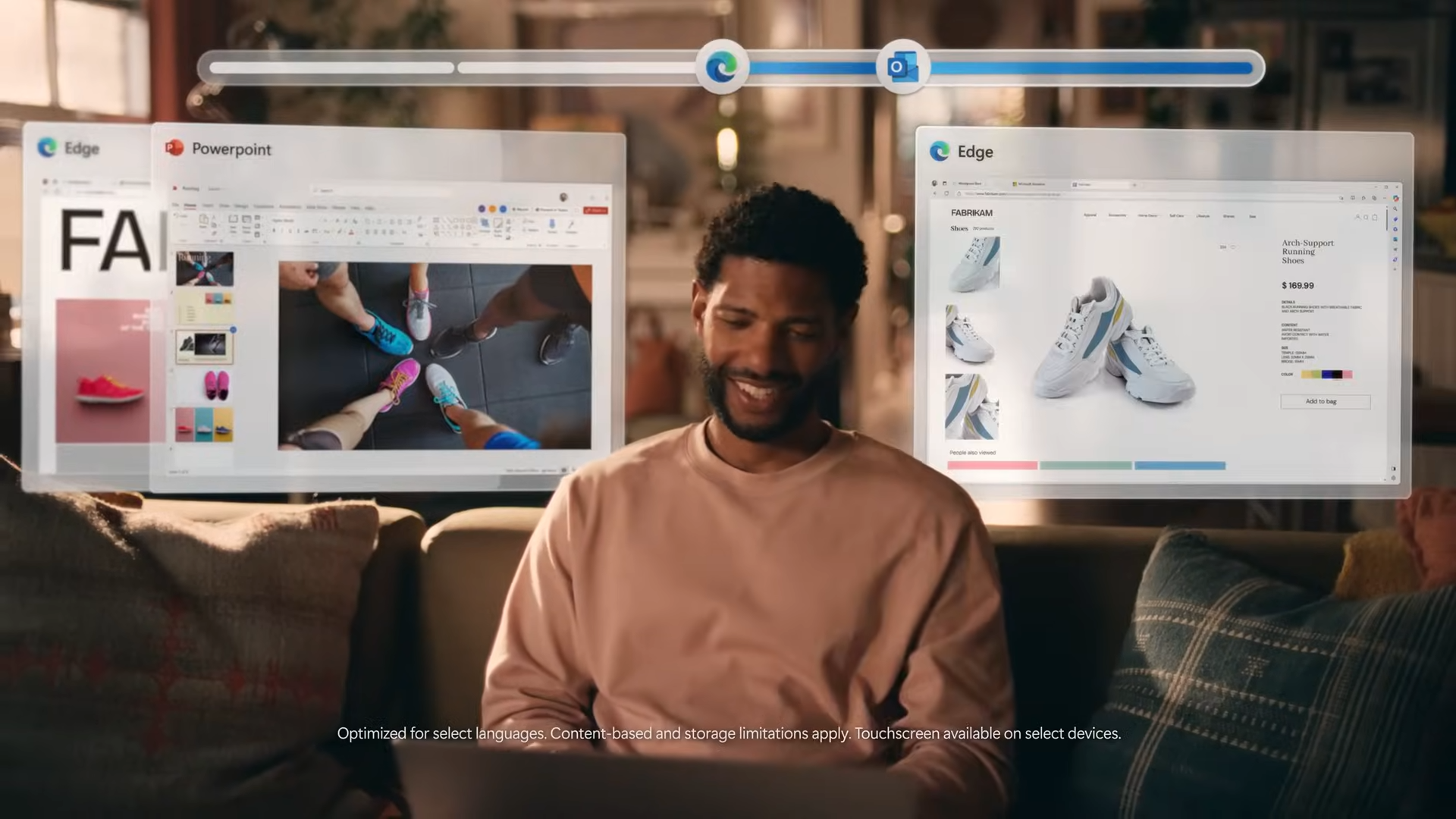Laptop Mag Verdict
The Razer Blade Stealth packs a powerful 8th-gen processor and a QHD display into a very sleek frame, but the battery life is still short.
Pros
- +
Slim, lightweight, understated chassis
- +
Bright, vivid quad-HD panel
- +
Fast SSD
- +
Powerful 8th-gen processor
Cons
- -
Subpar battery life
- -
Expensive
Why you can trust Laptop Mag
The road to perfection is cobbled with little tweaks as well as big improvements. Razer continues to walk that road with the latest model of the Blade Stealth. Priced at $1,699 (starting at $1,249), the ultraportable retains its slim dimensions and bewitching 13.3-inch display while adding an improved keyboard and a powerful 8th-gen processor, doubling down on its challenge to the ultraportable crown. However, the system is still hampered by battery life that's much too fleeting.
Design
Leave it to Razer to make me a liar. As much as I complain about the endless sea of gray in the laptop market, I immediately broke into an audible ooooooooh when I laid eyes on the Stealth. The Stealth's CNC aluminum just looks damned good in gunmetal gray. I don't even mind that the three-headed snake logo on the back isn't glowing. The way the light hits the semi-glossy emblem is almost as enticing.
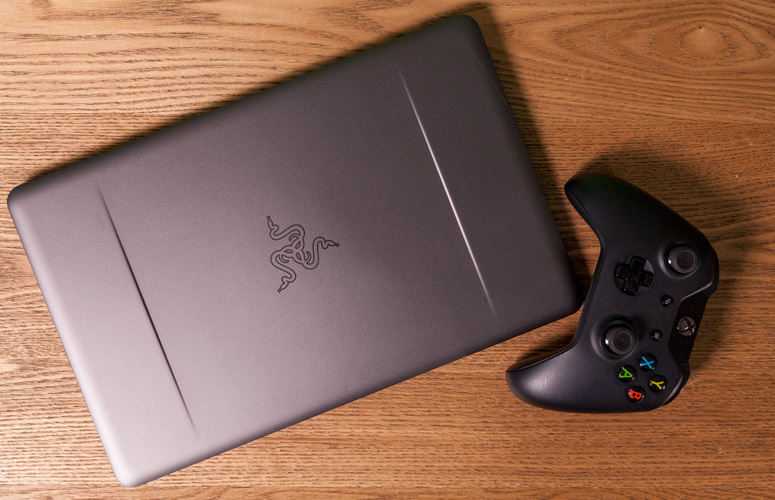
Outside of the color change, it's business as usual with the Stealth. Opening the lid unveils more gunmetal-gray aluminum, the 13-inch QHD display, the touchpad, the full-size backlit keyboard and the pair of speakers surrounding it. Like most modern ultraportables, the Stealth doesn't have a lot of room for ports. You get a USB 3.0 port and a full HDMI 2.0-out port on the right, with another USB 3.0 port, Thunderbolt 3 and a headset jack on the left.
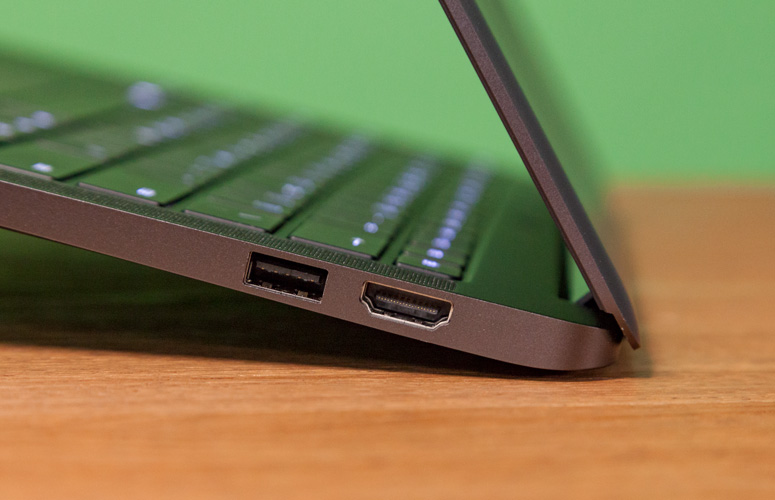
At 2.9 pounds, the 12.6 x 8.1 x 0.5-inch Stealth is one of the heavier lightweights on the market. The Lenovo Yoga 920 (12.7 x 8.8 x 0.6 inches) is heavier at 3.1 pounds, but the Dell XPS 13 (12 x 7.9 x 0.6 inches) and HP Spectre 13 (12 x 8.8 x 0.4 inches) weigh in at a waifish 2.8 and 2.4 pounds, respectively.
Display
How sharp is the Stealth's QHD (3200 x 1800), 13.3-inch IGZO touch screen? Sharp enough that I could see John Boyega's tightly coiled curls and the hexagonal mesh pattern on his Drivesuit during the Pacific Rim Uprising trailer. The colors aren't too shabby either, since the actor's warm chocolate skin seemed to glow against the black and steel-blue outfit.
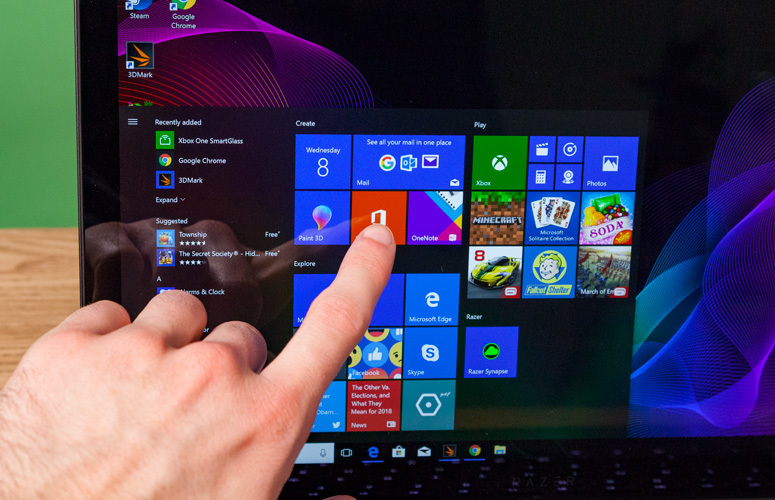
When we checked the panel for color reproduction, we found it surpassed the 102 percent ultraportable average with an impressive 121 percent. The XPS 13 and Spectre 13 weren't too far off at 112 and 111 percent, respectively, while the Yoga 920 notched 105 percent.
The Stealth's panel is also plenty bright, averaging 328 nits, outshining the 286-nit average as well as the Yoga 920 and the Spectre 13. The XPS 13 is the brightest in the land at 368 nits.
The 10-finger capacitive touch screen is quick to respond and accurate, keeping up with my random squiggles in Paint.
Audio
The Stealth's pair of top-mounted speakers are louder than you'd expect. The slim speakers filled my bedroom with loud, relatively clear audio, thanks to an assist from the preloaded Dolby Atmos software. However, listening to Michael Jackson's "The Lady In My Life," I noticed that while the artist's vocal was clear, the guitar sounded distorted at maximum volume, as did the keyboard.
Despite switching through the six presets (Dynamic, Movie, Music, Game, Voice and Personalize), I couldn't get rid of that slightly off-putting twang. To check for bass, I switched to Rick Ross' "3 Kings" and ran into that distorted piano again -- only this time, it was accompanied by wilted lows.
Keyboard and Touchpad
As much as I love the glittering, customizable cacophony that is a Razer Chroma keyboard, I can appreciate the boardroom-friendly white backlighting of the gunmetal-gray Stealth. Lack of colorful backlighting or not, I can't ignore that Razer has taken strides to improve the typing experience on the Stealth.
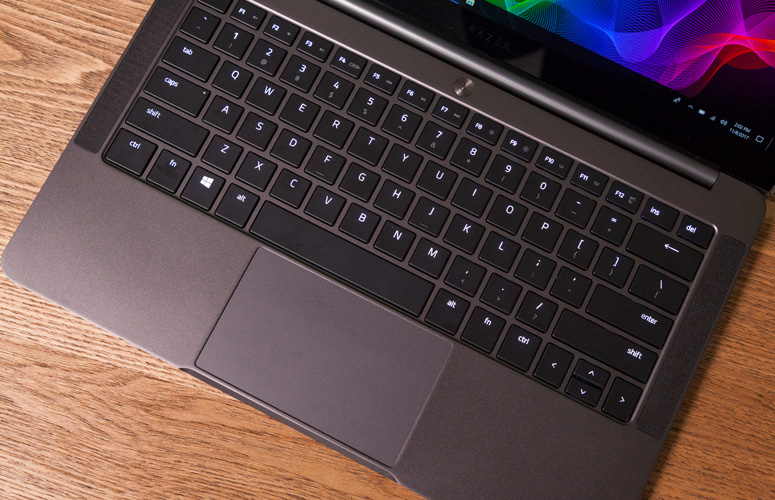
Despite its 1.2 millimeters of key travel and 69 grams of actuation (1.5 mm and 60 g are our minimum), the Stealth doesn't feel as shallow as previous models did. In fact, there's a little bit of pop in these keys. I hit my usual 65 words per minute on the 10fastfingers typing test.
The 4.1 x 2.5-inch precision touchpad is massive on such a small system. That means there was plenty of space for my fingers to call up Cortana with a three-finger press or zoom in on a document with a quick pinch-zoom. The bottom corners of the touchpad had firm feedback for a comfortable feel when I was left and right clicking.
Performance
The Stealth is the latest ultraportable to make the leap to an Intel 8th-gen processor. Intel upped the power on the new chips by adding four cores instead of two. According to our tests, we found that 8th-gen CPUs are nearly 92 percent faster than 7th gen, depending on what tasks you are performing. For example, I launched 24 tabs in Google Chrome, some of which ran YouTube, Twitch, Tweetdeck and Slack -- all while running a full system scan in Windows Defender without any lag.
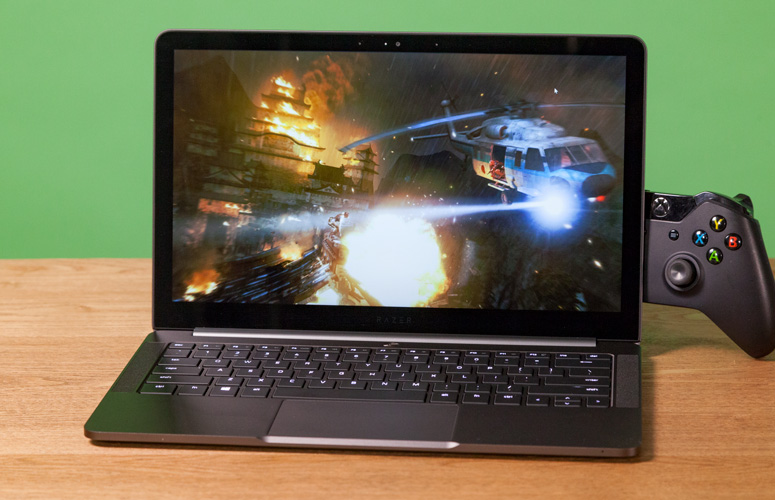
The laptop's 1.8-GHz Core i7-8550U processor with 16GB of RAM held its own on our synthetic performance tests. On Geekbench 4, which measures overall performance, the Stealth scored 13,694, which is nearly double the 7,058 ultraportable average. It's impressive, but par for the course when compared to other laptops with the same CPU. The Spectre 13, Yoga 920 and Dell XPS got 13,090, 13,306 and 14,158, respectively.
For our productivity test, we had the Stealth pair 20,000 names and addresses. It finished in 3 minutes and 21 seconds, smoking the 5:39 average. The Spectre 13 trailed behind with 3:29, but the Yoga 920 and XPS 13 posted faster times of 3:17 and 3:09, respectively.
When we ran the File Copy Test, the Stealth's 512GB m.2 PCIe SSD duplicated 4.97GB of multimedia files in 11 seconds. That's a rate of 462.6 megabytes per second, topping the 222.7-MBps average as well as the Yoga 920 and HP Spectre. However, the XPS 13 delivered a transfer rate of 508 MBps.
You can't play Destiny 2 with the Stealth's integrated Intel HD 620 GPU, but you can play a number of popular titles -- just not on the highest settings. The notebook notched 76,734 on the 3DMark Ice Storm Unlimited benchmark, defeating the 58,690 category average. Outfitted with their own 620 GPUs, the Spectre 13, Yoga 920 and XPS 13 nailed down 13,090, 13,306 and 14,158, respectively. If you want to play more taxing titles, check out the Razer Core external GPU.
The Stealth did do a bang-up job running Dirt 3, turning in a frame rate of 59 frames per second, surpassing the 41-fps ultraportable average. The Spectre 13 and XPS 13 weren't too far off, with scores of 57 and 56 fps, respectively, but the Yoga 920 trailed behind with 35 fps.
Battery Life
As with prior models, poor battery life is the albatross around the Stealth's neck. The notebook lasted only 5 hours and 21 minutes on the Laptop Mag Battery Test, which consists of continuous web surfing over Wi-Fi.
MORE: Laptops with the Longest Battery Life
That's far below the 8:27 ultraportable average as well as the scores for the Yoga 920 and XPS 13, which lasted 12:22 and 16:05, respectively. Even the Spectre 13 performed better, with a time of 6:03.
Software and Warranty
Although the Stealth is positioned to be a work-friendly device, Razer couldn't resist adding some gamer-centric software, on the off chance that you decide to hook it up to an eGPU. You get Razer's cloud-based Synapse app, allowing you to customize the color on other Razer peripherals, set macros and track your keystrokes. To manage your network priorities and monitor overall health, you have Killer Control Center and Killer Diagnostics.
The notebook also has Windows 10 preinstalled, which unfortunately comes with its fair share of bloatware, including Twitter, Facebook, Candy Crush Soda Saga, Asphalt 8, Fallout Shelter and Drawboard PDF, to name a few.
The Razer Blade Stealth comes with a one-year limited warranty. See how Razer fared on this year's Tech Support Showdown and Best and Worst Laptop Brands reports.
Configurations
I had the opportunity to review the $1,699 version of the Razer Blade Stealth, which has an 8th-gen, 1.8-GHz Core i7-8550U processor with 16GB of RAM, a 512GB m.2 PCIe SSD, an Intel HD 620 GPU and a 3200 x 1800 touch screen.
The $1,249 base model features a 7th-gen, 2.7-GHz Intel Core i7-7500U CPU, 16GB of RAM, a 512GB m.2 PCIe SSD, an Intel HD 620 GPU and a 4K (3840 x 2160) touch panel. Got money to burn? Then check out the $1,999 model, which keeps the 7th-gen processor, RAM and GPU, but adds a 1TB m.2 PCIe SSD and swaps out the 4K screen for a QHD panel.
Bottom Line
I'm frustrated. The Razer Blade Stealth does so many things right. For $1,699, you get a serious powerhouse packed with an 8th-gen Intel processor, a speedy SSD, enticing display and comfortable typing experience -- all in a frame that's just 0.5 inches thick. However, with all that win going on, there's one big loss that can't be ignored, and that's the subpar battery life. Less than 6 hours of power just doesn't make sense for an ultraportable.
If you're looking for something that can last beyond a full work day that has just a bit more power, check out the $1,299 Dell XPS 13. It's cheaper, has a gorgeous InfinityEdge display, an 8th-gen CPU and over 16 hours of battery life. But if you're looking for a stylish productivity machine that can moonlight as a gaming system (with an external GPU), you'd be hard-pressed to do better than the Razer Blade Stealth.
Razer Blade Stealth Specs
| Bluetooth | Bluetooth 4.2 |
| Brand | Razer |
| CPU | 1.8-GHz Intel Core i7-8550U processor |
| Company Website | www.razerzone.com |
| Display Size | 13.3 |
| Graphics Card | Intel HD Graphics 620 GPU |
| Hard Drive Size | 512GB |
| Hard Drive Type | PCIe m.2 SSD |
| Highest Available Resolution | 3200 x 1800 |
| Native Resolution | 3840 x 2160 |
| Operating System | Windows 10 |
| Optical Drive | None |
| Ports (excluding USB) | USB 3.0, Thunderbolt, Headset, HDMI 2.0 |
| RAM | 16GB |
| Size | 12.6 x 8.1 x 0.5 inches |
| Touchpad Size | 4.1 x 2.5 inches |
| USB Ports | 3 |
| Warranty/Support | 1-Year Limited Warranty |
| Weight | 2.8 |
| Wi-Fi | 802.11a/b/g/n/ac |
| Wi-Fi Model | Killer Wireless-AC |

Sherri L. Smith has been cranking out product reviews for Laptopmag.com since 2011. In that time, she's reviewed more than her share of laptops, tablets, smartphones and everything in between. The resident gamer and audio junkie, Sherri was previously a managing editor for Black Web 2.0 and contributed to BET.Com and Popgadget.
